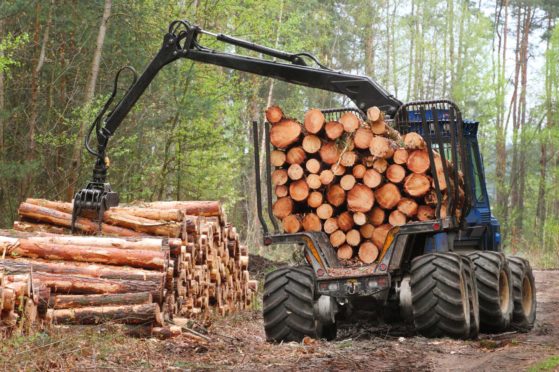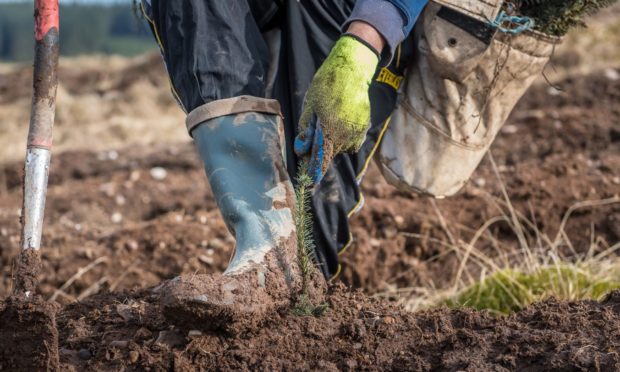Have you started a DIY project or house extension recently – or looked to buy a new garden shed or fence?
If so, you’ll know the cost of wood has increased significantly, with delivery dates extended by months in some cases.
While there are one-off reasons for the current situation, there are also important broader global trends at play. They can be encapsulated in a few words: the world wants wood.
Questions are sometimes raised about the types of woodland we create in Scotland with some saying we should only plant so-called native trees.
This would be akin to saying let’s only breed native sheep and cows or grow crops that are native to Scotland – potatoes would be out, as would many breeds of sheep.
There are good reasons for working with certain introduced species. The market for wood is overwhelmingly softwood (from conifer trees), and in Scotland we only have three native species – Scots Pine, Yew and Juniper.
Juniper is great for gin and yews for graveyards. Scots Pine is suitable for some wood products but not all, and only grows well on certain soils.
Palette of species
Alongside native trees, the Scottish forestry sector has evolved to use a palette of introduced species suitable to our climate and soils, which can provide the range of softwood products we need.
Crucially, we have also worked with government, environmental organisations and public access groups to establish robust standards for the use of those species in forests that balance products with people and wood with wildlife.
If we don’t produce wood, we have stark questions to answer:
– Will we import more wood or use more carbon-hungry materials like steel, concrete and plastics?
– How will we replace the bulk of the 25,000 mainly rural jobs that the forestry and wood sector supports in management, harvesting, processing and replanting?
– How on earth will we achieve net-zero by 2045?
At the moment, demand for wood is extremely high, and growing. WWF (the World Wide Fund for Nature) has predicted that global demand for timber will triple by 2050; other estimates put future demand even higher.
Why is demand so high? In many ways, wood is the sustainable and renewable material the 21st Century needs. It locks up carbon, requires little energy to produce (compared to steel and concrete) and it is easily reused and recycled. At the end of its life, it can be used to produce renewable energy.
Technology and innovation is increasing wood’s use in large buildings and it can even be used as a substitute for oil-based products.
Wood is also a beautiful material that people love to have around their homes and gardens – which is why many of us are looking at those DIY projects just now.
Increased demand
As timber demand charges ahead, supplies are struggling to catch up. Few countries are planting new forests, which means long-term wood supply could be even more challenging, and prices will rise even higher.
Scotland is planting new forests; 80% of the UK’s new woodland is being created in modern, mixed forests delivering a wide range of benefits for our environment, economy and society.
This supports Scotland’s aim to be net-zero – where greenhouse gas emissions are balanced out by their removal from the atmosphere – by 2045. This is five years before the rest of the UK.
This planting ambition was laid out in the 2019-2029 Scottish Forestry Strategy, debated and endorsed with cross-party support in the Scottish Parliament – and the planting is regulated by Scottish Forestry, in accordance with the strict UK Forestry Standard (UKFS).
The UKFS ensures all potential impacts of new forests are considered when they are planted.
Guidelines in the UKFS, which are revised every five years, cover biodiversity, climate change, historic environment, landscape, people, soil, and water.
Anyone wishing to create a new woodland is required to consult locally. Wouldn’t it be wonderful if all industries had to comply with such detailed and demanding requirements?
These standards mean modern forestry must meet very high standards and deliver multiple benefits – they are a very clear break with the past, when in the 1980s it was possible to plant monocultures.
If someone says we shouldn’t plant monocultures now, I agree with them… because we don’t do it.
If someone says modern forests should support wildlife, I agree with them… because they do.
Last year Confor reviewed the available evidence and produced our Biodiversity, Forestry and Wood report.
It shows the wide range of wildlife supported by productive forests, and the good news is that the new forests we are creating will deliver even more.
Please have a read and talk to us about it – and about any issues that concern you.
There are those who make simple statements about forestry. Simple statements usually belie complex issues.
All I ask is for people not to put modern, productive forestry in a box and criticise us without the full picture – because one part of that picture can’t be ignored; over time, we will all need more wood.
● Stuart Goodall is chief executive of Confor: promoting forestry and wood


